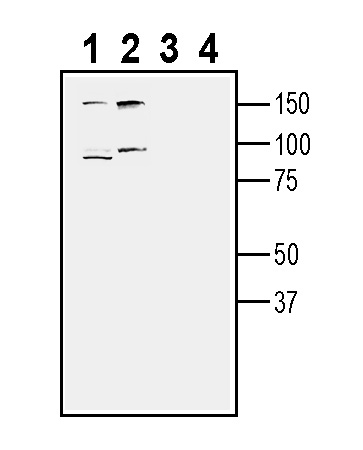Overview
- Peptide (C)GPYKLSWVQENGTQDE, corresponding to amino acid residues 346 - 361 of mouse TYRO3 (Accession P55144). Extracellular, N-terminus.

TYRO3 (extracellular) Blocking Peptide (#BLP-TR031)
 Western blot analysis of mouse brain membranes (lanes 1 and 3) and rat brain membranes (lanes 2 and 4):1-2. Anti-TYRO3 (extracellular) Antibody (#ATR-031), (1:200).
Western blot analysis of mouse brain membranes (lanes 1 and 3) and rat brain membranes (lanes 2 and 4):1-2. Anti-TYRO3 (extracellular) Antibody (#ATR-031), (1:200).
3-4. Anti-TYRO3 (extracellular) Antibody, preincubated with TYRO3 (extracellular) Blocking Peptide (BLP-TR031). Western blot analysis of human THP-1 monocytic leukemia cell line lysate (lanes 1 and 3) and human K562 chronic myelogenous leukemia cell line lysate (lanes 2 and 4):1-2. Anti-TYRO3 (extracellular) Antibody (#ATR-031), (1:200).
Western blot analysis of human THP-1 monocytic leukemia cell line lysate (lanes 1 and 3) and human K562 chronic myelogenous leukemia cell line lysate (lanes 2 and 4):1-2. Anti-TYRO3 (extracellular) Antibody (#ATR-031), (1:200).
3-4. Anti-TYRO3 (extracellular) Antibody, preincubated with TYRO3 (extracellular) Blocking Peptide (BLP-TR031). Western blot analysis of human Malme-3M melanoma cell line lysate (lanes 1 and 3) and human PANC1 pancreatic duct carcinoma cell line lysate (lanes 2 and 4):1-2. Anti-TYRO3 (extracellular) Antibody (#ATR-031), (1:400).
Western blot analysis of human Malme-3M melanoma cell line lysate (lanes 1 and 3) and human PANC1 pancreatic duct carcinoma cell line lysate (lanes 2 and 4):1-2. Anti-TYRO3 (extracellular) Antibody (#ATR-031), (1:400).
3-4. Anti-TYRO3 (extracellular) Antibody, preincubated with TYRO3 (extracellular) Blocking Peptide (BLP-TR031).
- Robinson, D. R., et al. (2000) Oncogene 19, 5548–5557.
- Lemke, G. (2013) Cold Spring Harb. Perspect. Biol. 5, 11.
- Burstyn-Cohen T, et al. (2019) Cell Commun Signal. 17, 156.
- van der Meer JH, et al. (2014) Blood. 123, 16.
- Smart, S. K., et al. (2018) Cancers (Basel). 10, 474.
TYRO3 (also called Brt, Dtk, Etk-2, Rek, Rse, Sky, and Tif) is a member of the TAM family (TYRO3, AXL, and MERTK) of receptor tyrosine kinases (RTKs). This family is characterized by a highly conserved intracellular tyrosine kinase domain, and shared ligands Gas6 and Protein S. TYRO3 functions as homeostatic regulator of many systems and as an onco-protein.
Subfamilies of RTKs are categorized based on their amino acid sequences and extracellular structural similarities. Members of a subfamily often bind common or similar ligands.1 The TAM family functions as homeostatic regulators of cell proliferation, differentiation, survival and migration, and as such, are associated with cancer development and metastasis.2 Stimulation of TAM receptors by cognate ligands Gas6 and Protein S can produce diverse cellular functions depending on the ligand–receptor combination as well as the cell type and microenvironment. For example, MERTK is best known for its mediation of cell engulfment by macrophages in the apoptosis process. In the CNS, Axl plays a role in phagocytosis of apoptotic cells by microglia. However, TYRO3 does not participate in these phagocytic processes.
Gas6 (also known as Growth arrest-specific 6) and protein S are homologous proteins. They are members of the vitamin K-dependent family of proteins. Functions of Gas6 seem to be mediated exclusively by activation of the TAM receptors. In contrast, protein S takes part in other mechanisms, and is especially known for its role as a cofactor for activated protein C in the breakdown of coagulation factors. Gas6 and protein S appear to bind to TAM receptors as dimers. They serve as a “bridging molecule” that physically links a TAM receptor, to phosphatidyl-serine (PtdSer), which is displayed on the surface of the target cells.
Activation of TYRO3 by its ligands is enhanced by PtdSer in a concentration-dependent manner, suggesting that local PtdSer concentrations may fine-tune TAM signaling and function. This interaction can occur on any PtdSer-expressing moiety, including apoptotic cells, tumor vasculature or viral particles.3 TYRO3 is expressed in a variety of tissues including the nervous, immune, reproductive, hematopoietic, and vascular systems. It regulates many physiological processes including cell survival, migration and differentiation. Following activation by its ligand, TYRO3 initiates homophilic dimerization, auto-phosphorylation, and downstream signaling through the PI-3K/AKT or Ras/ERK signaling pathways.
TYRO3 plays a role in neuron protection from excitotoxic injury. TYRO3 knockout young adult mice suffered from diminished hippocampal long-term potential, and old mice suffered from neural degeneration, seizures and paralysis.4
TYRO3 also takes part in platelet aggregation and cytoskeleton reorganization. It regulates inflammation by inhibition of the Toll-like receptors (TLRs)-mediated innate immune response. In addition, TYRO3 is an oncoprotein, with overexpression many cancers, including hepatocellular carcinoma, colon, breast and lung cancer.5
TYRO3 has been found to function as entry factor for the hemorrhagic fever filoviruses family. In a process termed “apoptotic mimicry”, the eat-me signal PtdSer has been found to be displayed on the extracellular membrane surface of several enveloped viruses, including cytomegalovirus, Ebola virus, Lassa fever virus, Zika virus, and HIV. Gas6 and Protein S again serve as “bridging molecules”—this time between a membrane that surrounds a virus capsid and the cell that the virus will infect.2
Application key:
Species reactivity key:
Anti-TYRO3 (extracellular) Antibody (#ATR-031) is a highly specific antibody directed against an extracellular epitope of the mouse protein. The antibody can be used in western blot and flow cytometry applications. It has been designed to recognize TYRO3 from mouse, rat and human samples.

